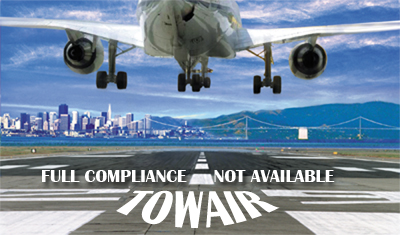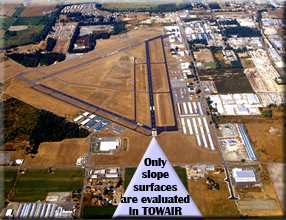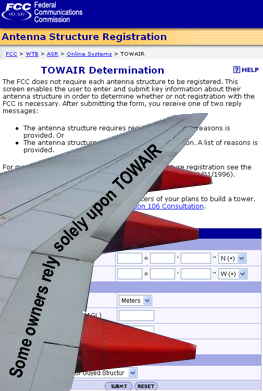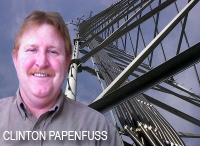|
Reliance solely on TOWAIR tool for FAA approval is not in nation's tower owners' best interest
By Clinton Papenfuss
October 20, 2006 - Americans used an incredible number of minutes on their cell phones during the first six months of this year, 850 billion, to conduct business, keep in touch with family and friends, and for emergencies. 
This would not be possible without the cell tower companies that provide the carriers’ infrastructure. As an industry, we strongly believe in safety, not only on the ground but also in the air. As a result, we take steps to ensure the flying public will be safe from our structures before moving forward in the process to choose a site for a new communications tower, regardless of the proposed height of the tower.
TOWAIR is only one tool that is available
The tower industry utilizes many tools to make sure that the structures being erected are as safe as possible. Air safety can only be ensured if the regulations contained in FAA CFR Title 14, FAA Part 77 and CFR Title 47, FCC Part 17 are followed.
To identify that we are in full compliance with these regulations and any related rules, we are required to use many resources. There is, therefore, no way to quickly respond to: “Is my proposed structure in full compliance?” we are required to use many resources. There is, therefore, no way to quickly respond to: “Is my proposed structure in full compliance?”
It takes years of experience and means to come to the correct answer. Unfortunately, one tool that some tower developers use as the sole basis for “The Answer,” is the FCC’s software program TOWAIR .
I do not feel that TOWAIR is the answer for the following reasons:
- TOWAIR only evaluates the 100:1, 50:1, and 25:1 slope surfaces as indicated in FCC Part 17, Paragraph 17.7 and FAA Part 77 , Paragraph 77.13.
- TOWAIR does not evaluate the surfaces contained in CFR Part 77 , Paragraph 13, (a) (4), IFR instrument approach procedures.
- TOWAIR does not evaluate the surfaces contained in CFR Part 77 , Paragraph 77.23, Standards for Determining Obstructions.
- TOWAIR does not evaluate the surfaces contained in CFR Part 77 , Paragraph 77.25, Civil Airport Imaginary Surfaces.
- TOWAIR does not evaluate the surfaces contained in CFR Part 77 , Paragraph 77.28, Military Airport Imaginary Surfaces.
- TOWAIR does not evaluate the surfaces contained in CFR Part 77 , Paragraph 77.29, Airport Imaginary Surfaces for Heliports.
- TOWAIR does not evaluate to determine the VFR effects of a proposed structure.
In reference to the second item above, most instrument approach procedures have a final approach course that is between 4 and 6 NM long with some going out to 10 NM from the airport. The area considered in a TOWAIR study goes for a maximum distance of 20,000 feet from the closest landing surface at public use airports and heliports. This can be a real problem to aircraft safety; there are instrument approach procedures throughout the country that would be exceeded by a 200' AGL structure. TOWAIR will never identify a proposed structure that would exceed an instrument approach procedure.
Additionally, the FCC acknowledges that there are errors in the TOWAIR Software and provide the following disclaimer in each of the TOWAIR results:
“TOWAIR’s findings are not definitive or binding, and we cannot guarantee that the data in TOWAIR are fully current and accurate. In some instances, TOWAIR may yield results that differ from application of the criteria set out in 47 C.F.R. Section 17.7 and 14 C.F.R. Section 77.13. A positive finding by TOWAIR recommending notification should be given considerable weight. On the other hand, a finding by TOWAIR recommending either for or against notification is not conclusive. It is the responsibility of each ASR participant to exercise due diligence to determine if it must coordinate its structure with the FAA. TOWAIR is only one tool designed to assist ASR participants in exercising this due diligence, and further investigation may be necessary to determine if FAA coordination is appropriate.”
TOWAIR was designed by the FCC to provide antenna structure owners the ability to easily determine whether their structures are close enough to an airport or heliport to require an aeronautical study by the FAA and registration with the FCC.
However, please remember TOWAIR is not the answer. Just as a home builder does not use a hammer and saw alone to construct a new home, the airspace specialist utilizes many tools to achieve the correct answer. Let's be safe out there and use all we can to make sure that we provide the public with the safest flying environment possible.
|
 Clinton Papenfuss is the Airspace Analyst for SBA Communications. He has 16 years experience as an Air Force Air Traffic Controller, 17 years experience as a Terminal Instrument Procedures Specialist (TERPS), and 8 years experience as an Airspace Analyst. He can be contacted at SBA Communications, (800) 487-7483. Clinton Papenfuss is the Airspace Analyst for SBA Communications. He has 16 years experience as an Air Force Air Traffic Controller, 17 years experience as a Terminal Instrument Procedures Specialist (TERPS), and 8 years experience as an Airspace Analyst. He can be contacted at SBA Communications, (800) 487-7483.
Additional References: Federal Regulations Pertaining to Obstruction and Aviation Lighting
|
|